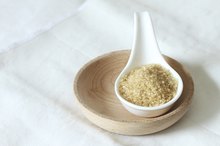How to Treat Battlefield Wounds With Sugar
**Sugar—and its cousin, honey—have been used to treat wounds for thousands of years.
** Modern research has proven its medical abilities, including providing topical nutrition, stimulating tissue growth, reducing inflammation and exhibiting broad-spectrum antimicrobial action.
Battlefield conditions require effective, inexpensive, easy-to-use and non-toxic methods for treating wounds. Sugar meets these conditions and should be included in all medic supply kits.
Sugar and Sugar Paste
Treat wounds with necrotic cellulitis with plain granulated sugar. Clean the area around wound. Surround the wound with petroleum jelly or the ostomy ring to help contain sugar. Pour sugar liberally onto the wound, covering it completely and evenly. Apply the dressing. Repeat two to four times daily until the infection is healed, rinsing the wound as needed before adding more sugar.
How to Avoid Sugar If You Have Staph Infections
Learn More
Use sugar paste for other wounds 13. Determine the type and size of the wound and the thickness of the paste required. Use thin paste, with a honey-like consistency, for wounds with small openings, such as extensive tracking sinuses. Use thick paste, resembling modeling clay, for wounds with large openings, such as pressure sores.
Prepare the sugar paste 3. Both Seal and Newton state that sugar paste should be prepared in a pharmacy. If paste is prepared in the field, use extreme care to avoid contamination. Mix polyethylene glycol with hydrogen peroxide. Add sugars. Mix with a blender or whisk until smooth. Store the paste at room temperature for up to six months, or at 2 to 8° C for up to a year.
Symptoms of a Sugar Allergy
Learn More
Apply the sugar paste 3. As for granulated sugar, clean the wound and the surrounding area. If using thick paste, mold the paste with gloved hands to appropriate size and shape. Immediately pack the wound cavity. Ensure that the wound is covered completely and evenly. Cover with a fresh dressing. If using thin paste, fill a syringe with paste. Use the tube or catheter to apply the paste to the wound or irrigate the sinus passages. Cover with fresh dressing.
Apply the paste twice daily for optimum antibacterial effect. More severe wounds may require packing every three to four hours. Discontinue using the sugar paste once the infection is resolved, or continue daily treatments until complete healing occurs.
- Treat wounds with necrotic cellulitis with plain granulated sugar.
- Use thin paste, with a honey-like consistency, for wounds with small openings, such as extensive tracking sinuses.
- As for granulated sugar, clean the wound and the surrounding area.
Notes
The sugar paste should dissolve within four hours and will act as an irrigant, removing the need to rinse wound further.
Watch for bleeding while granulation tissue forms. Apply non-impregnated dressings to the wound to keep it moist and allow epithelialization to occur.
Skin surrounding the wound may show maceration caused by increased exudates. Use the appropriate barrier protection as part of the plan of care to prevent complications.
Expect the wound to remain moist during treatment, even though sugar creates low water activity and high osmotic pressure.
In late healing stages, replace the sugar paste with silastic foam, if desired.
Tips
Researchers have found sugar most effective on infected and malodorous wounds.
Warnings
Use sugar paste with care if the patient has impaired renal function, because absorbed polyethylene glycol is excreted renally. Also, high blood levels of this ingredient can be nephrotoxic.
Under European Union regulations, a tub of sugar paste must be used solely for one patient and discarded within 24 hours after opening. While no similar U.S. regulations apply, use common sense and universal precautions to prevent the contamination of paste and the spread of infectious pathogens.
- The sugar paste should dissolve within four hours and will act as an irrigant, removing the need to rinse wound further.
- Apply non-impregnated dressings to the wound to keep it moist and allow epithelialization to occur.
Related Articles
References
- “Surgical Infections” magazine; The Utility of Sugar for Complicated Wounds: An Old Solution Worth Revisiting; Chad G. Ball, Ravi R. Rajani, Jeffrey P. Salomone, and Gary A. Vercruysse; 2009
- “Skin and Wound Infection: Investigation and Treatment in Practice;” David V. Seal, Roderick J. Hay, Keith R. Middleton; 2000
- “Nursing Times” online magazine; Using sugar paste to heal postoperative wounds; Heather Newton, RGN, DipPSN; Vol: 96, Issue: 36, Page No: 15, Sept. 7, 2000
Tips
- Researchers have found sugar most effective on infected and malodorous wounds.
Warnings
- Use sugar paste with care if the patient has impaired renal function, because absorbed polyethylene glycol is excreted renally. Also, high blood levels of this ingredient can be nephrotoxic.
- Under European Union regulations, a tub of sugar paste must be used solely for one patient and discarded within 24 hours after opening. While no similar U.S. regulations apply, use common sense and universal precautions to prevent the contamination of paste and the spread of infectious pathogens.
Writer Bio
Based in Brazos County, Texas, Jennifer Wiginton has been writing and editing since 1989. She has published two cookbooks and articles in “The Joyful Woman” and “The Common Bond.” Wiginton has two degrees and a Certificate in Homeland Security from Texas A&M University.









